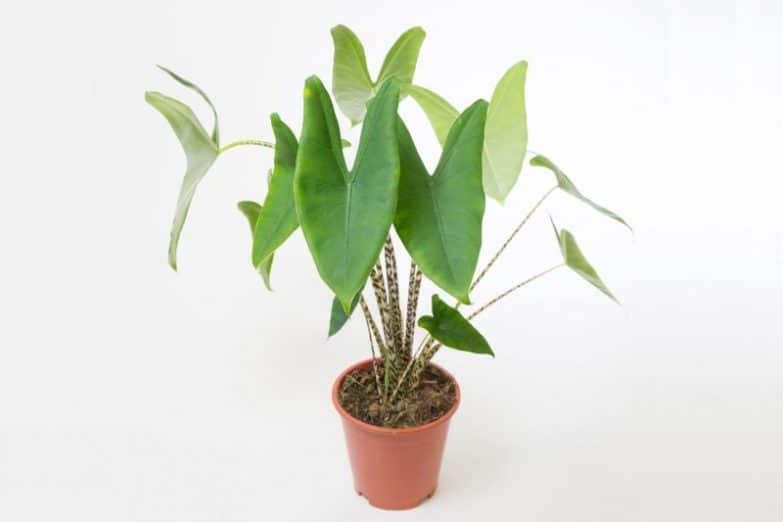The unusual Alocasia zebrina has exotic striping on its stilt-like stalks that add pizzaz to any collection. They aren’t the easiest houseplant to manage, but they flourish indoors with the right routine. In this article, we’ll explain all you need to know about Alocasia zebrina care and how to prevent common problems.
Summary of Alocasia zebrina care: This frost-tender tropical requires warm temperatures and moist soil that never gets soggy. They need bright indirect light but scorch in direct sun. Zebrinas prefer high humidity and are medium to fast-growing with fortnightly feedings through the growing season; they go dormant in winter. Toxic to pets and humans.
Overview Of The Alocasia Zebrina
Instead of ornamental flowers or foliage, the Alocasia zebrina is mainly prized for its stems. Overcollection in the wild made the plant rare and costly after its introduction, but tissue culture has made it more widely available.
The Zebrina is an Alocasia: along with similar-looking Colocasias, the family is commonly known as an Elephant Ear. The plant features upright, arrowhead-shaped green with solid or reticulated leaves. Its standout feature is zebra-patterned striping along the thin stems. There are several other alocasias commonly grown as houseplants, including Alocasia Amazonica, which is a favorite of mine.
The plant is an evergreen member of the wide-ranging and diverse Alocasia genus. It originated in warm, humid Philippine rainforests, living at a high and well-drained elevation in bright shade as part of the forest undergrowth.
The Alocasia zebrina grows to about three feet high and wide. It can be considered rather fast-growing in the warm season, putting out leaves once every two weeks under ideal conditions. It sheds older leaves naturally and replaces them with new foliage.
The plant needs good light and a little extra watering attention but isn’t too hard to please. Its main vulnerability in containers is a rhizome root system that can easily rot in wet soil.
Alocasia Zebrina Care Summary
| Scientific Name | Alocasia zebrina |
| Origin | The Philippines |
| Size | 3 feet tall and wide at maturity |
| Light Requirements | Bright, indirect sunlight. Can tolerate lower light quite well. |
| Watering | Water once the top half-inch of soil is dry. Small amounts of water at a time, rather than completely dousing the soil, reduces the risk of root rot. |
| Soil | Extremely well-draining potting mix. Equal parts peat, perlite, and compost works well. |
| Temperature | 60ºF (15ºC) to 82ºF (28ºC). They can survive short dips to the low 30s, but they are not frost tolerant. Avoid hot or cold drafts. |
| Fertilizer | Feed every two weeks while actively growing with a ½-dilution of a balanced formula. Flush the soil every few months to prevent salt build-up. |
| Humidity | High humidity is important. >60% is ideal. |
| Flowering | Very unlikely to flower when grown in containers. Hooded spathes surrounding a white, stick-like spadix are produced in late spring but are unimpressive. |
| Pruning | Remove damaged or yellowing leaves. Otherwise, little pruning is required. |
| Propagation | Best propagated by division while actively growing. |
| Re-Potting | Avoid repotting unless very root-bound. The delicate roots can easily be damaged during repotting, which can negatively impact the plant. |
| Diseases and Pests | Damp conditions increase the risk of leaf spot diseases and root rot. Fairly pest resistant, but aphids, mealybugs spider mites and scale can sometimes cause problems. |
| Toxicity | Toxic if ingested by humans or animals. Sap can also cause skin irritation. |
| Where To Buy | Buy Alocasia zebrina online at Etsy (I buy most of my houseplants from Etsy). |
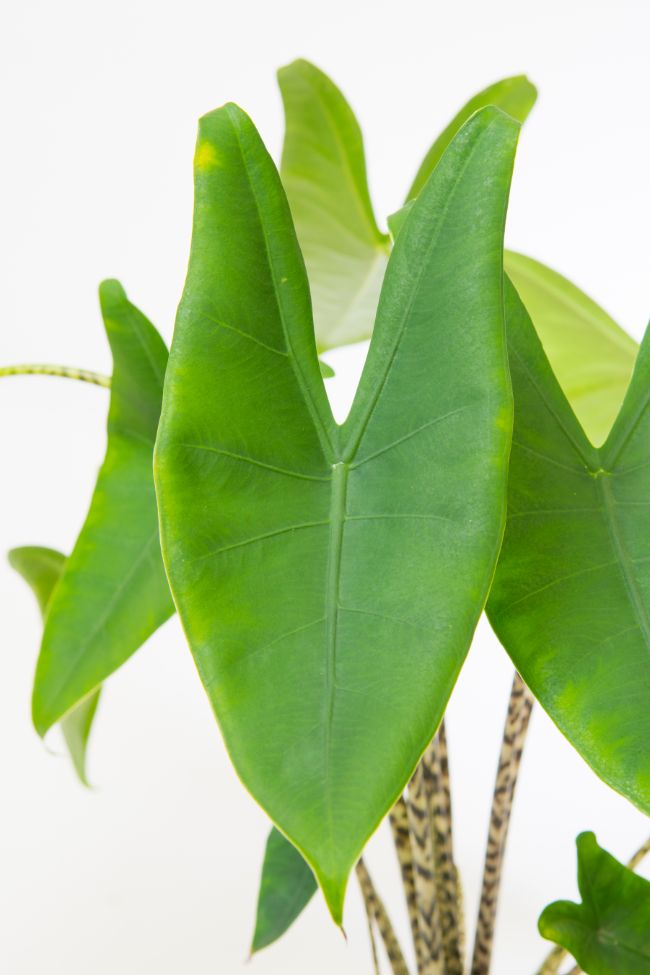
Indirect Bright Light
The Alocasia zebrina’s leaves act as broad solar panels designed to soak up light from bright shade under a sun-drenched jungle canopy. They happily absorb a great quantity of indirect sunlight but will scorch in direct sunlight.
You can easily satisfy the plant’s preferred conditions in a bright window. A southern exposure protected by sheer curtains works well, as does a spot four to six feet away from the open glass. Another option is to let them have an hour or so of direct early or late sunlight in an east- or west-facing window.
Zebrinas can survive in slightly lower light, but they don’t do well in dim conditions. Brighter illumination means more leaves—and those eye-catching stems!
Note: The leaves grow aggressively toward their light source and will eventually become lopsided without intervention. Maintain a balanced shape by rotating the pot 90º each time you water.
Careful, Consistent Watering
Alocasia Zebrina likes soil moisture, but they are easy to overwater and susceptible to root rot. Because the striped stems hold a lot of moisture, they don’t need a lot of water each session.
The Alocasia zebrina isn’t a drought-tolerant plant, however: its leaves turn brown and crispy in dry conditions. The need to preserve slight moisture without either wet or dry soil means your Zebrina requires a different watering routine than most houseplants.
Instead of thoroughly soaking the soil, it’s better to water them more frequently in smaller amounts. Unless the soil is exceptionally well-draining, you shouldn’t thoroughly douse the soil to flush it every session.
Generally the top ½-inch of topsoil should go dry before rewatering. The ideal time to give them a drink is just before they need it. Give them only enough to last a week … or even less.
If you’re using tap water, dechlorinate it first and serve at room temperature. Always check the soil before watering: Don’t follow a set schedule.
Watering By Feel
One common and effective method for watering an Alocasia zebrina properly is to pick up the pot to see how heavy it is. With experience, you can tell by the container’s weight when the plant is ready for another drink.
To discover the right weight, watch the leaves. A Zebrina’s foliage begins to droop when they need water – of course, you don’t want this to happen regularly, but this signal can be useful. Whenever the plant begins to wilt, pick up its container and feel how light it is.
Get to know that weight. With practice, you can simply lift the pot to judge whether it needs water. Read this article for some more helpful tips to get watering just right for your houseplants.
The Dormancy Factor
Let the soil dry out a bit more in the winter. Allowing the top two inches of topsoil to dry before watering during dormancy is a good approximation.
Note that periods of droughts can trigger the Alocasia to enter a dormancy cycle. It’s easy to overwater if you aren’t aware of this. Avoid problems by staying consistent with your watering and monitoring the soil day-to-day.
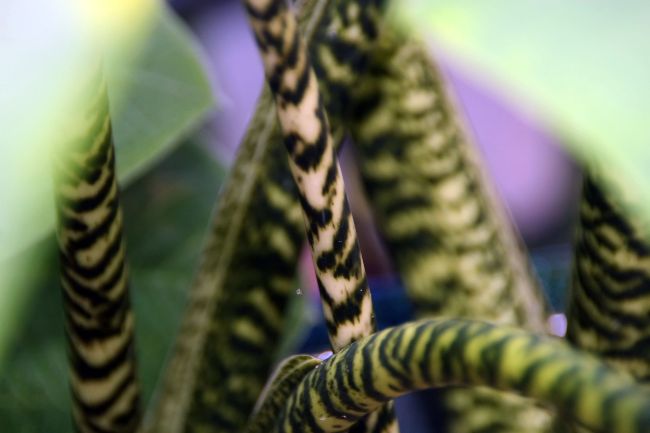
Soil Requirements
An airy, well-draining soil that holds moisture is the best mix for an Alocasia zebrina. Their natural habitat consists of humus-rich soil layered over a rocky substrate at high elevation … the plant struggles in a medium that holds too much water.
Alocasias are medium to heavy feeders. The key to providing adequate nutrition is a foundation of rich, well-draining soil. The plant does especially well in a natural mix with a lot of organic material.
The only caveat to adding organic material is that it breaks down over time and eventually causes soil compaction. Because a compact medium reduces oxygen and encourages root rot, it’s a good idea to provide additional aeration with perlite, pumice, or coarse sand.
Just remember that inorganic amendments are durable and keep the soil open, but they don’t add beneficial nutrition. Read more about choosing and making houseplant soil in this article.
Growing In Water
Given the plant’s susceptibility to root rot, it may seem surprising that some gardeners have success growing Alocasia zebrina directly in water. Strangely enough, though their roots certainly need access to oxygen, water can allow more gas exchange than sodden soil.
Sometimes water culture can revive an Alocasia zebrina that is failing in improper soil. It’s also a way to root new offsets. Here are some tips if you want to try this method:
- Wash away existing soil from the root system.
- Remove any rotted portions before submerging the rootball in water.
- Be careful to give the plant strong indirect light without direct exposure.
- Change the water every week to 10 days.
It’s best to use filtered and dechlorinated tapwater, rainwater, or distilled water when growing a Zebrina this way. You can periodically add diluted fertilizer for a brief time, but remember to change the water afterwards to avoid shocking the roots.
Humidity Preferred
As a rainforest dweller, the Alocasia zebrina naturally prefers high humidity. Their ideal level is 60% or above, so they do well in a greenhouse or in a room with a humidifier. They can usually get by with less, however, as long as they are watered correctly and given good light.
Browning leaves are a common sign the plant is struggling with lack of moisture in the air. You can group plants to raise humidity in your own indoor jungle, but don’t crowd them too closely. They still need air circulation and some distance to impede traveling pests.
Another good trick is to fill a tray or saucer with water so it will evaporate and increase local humidity. You can put the trays near the plant, or put pebbles in the water and place the pot on top to keep the soil safely dry. Read more about how to increase humidity for your houseplants here.
Comfortable, Warm Temperatures
The Alocasia zebrina doesn’t tolerate cold; even a slight chill is likely to cause leaf loss. They need to be kept in normal indoor temperatures between 60ºF (15ºC) to 82ºF (28ºC). They are hardy when planted outdoors in USDA Zones 10-11.
The plant goes dormant if the temperature falls much below their preferred range. They are tender and cannot handle a frost. Avoid hot or cold drafts and abrupt temperature changes.
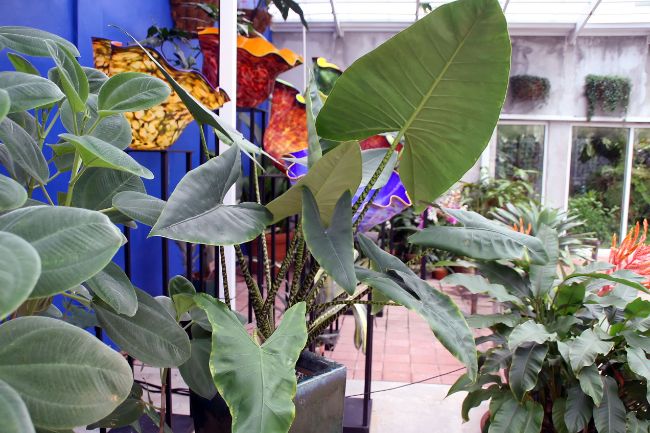
Frequent Fertilization
Alocasias are generally heavy feeders, but they only need extra nutrition during the warm months. You’ll overdose a dormant plant if you continue feeding according to their growing-season schedule.
It’s recommended to feed the plant every two weeks with a ½-dilution of a balanced formula. One easy method is to add liquid fertilizer to their water.
Some growers instead use a slow-release fertilizer every month to six weeks through the growing period.
Organic fertilizers are gentle, safe, and help increase the soil’s microbial health. A synthetic blend can more affordably meet the requirements of a fast-growing Alocasia zebrina; but, since they aren’t regularly flushed out by the plant’s watering regimen, unwanted salt residues can build up over time. Read more about how to fertilize houseplants here.
Minor Flowering
To say the Alocasia zebrina isn’t grown for its flowers is an understatement. The late spring “blooms” are hooded spathes surrounding a white, stick-like spadix. Healthy older specimens have been known to produce these synflorescences in containers, but it’s a pretty rare event.
To further dampen enthusiasm, their spathe isn’t technically a flower, botanically speaking. It’s actually a cover for the stalk that holds a myriad of tiny blooms along along its length. The flowers themselves are almost microscopic.
Prune As Needed
Pruning an Alocasia zebrina falls under the heading of grooming. You should remove yellowing or damaged leaves, but the Zebrina is a naturally large plant that doesn’t react to being cut back by becoming shorter and bushier.
Pro tip: If you want smaller foliage, try removing some older large leaves and feeding the plant adequately while giving it stronger light.
Cut foliage back close to – but not flush with – the main stalk. Use a sterile cutting blade to avoid infection. Dipping the blades in regular isopropyl (rubbing) alcohol is a simple sterilizing method.
Alocasia zebrinas are toxic and can cause skin irritation, so always put on waterproof gloves before handling them.
To aid recovery, the best time to trim your Zebrina is when they are growing quickly in temperatures above 80ºF (27ºC).
Repot Infrequently
You shouldn’t be in a hurry to repot. It disturbs the fragile roots and the plant will likely take time to recover. If you’ve recently acquired a new Alocasia zebrina, let it acclimate to its new environment before transplanting.
Here are some repotting tips:
- The Zebrina doesn’t mind being a little rootbound. Wait until your plant needs watering more than once a week and its roots are starting to circle the bottom.
- The plant also doesn’t mind a smaller pot. Just make sure the container is heavy enough to avoid toppling.
- Replace the soil with a similar composite to avoid shocking the plant.
- Monitor the soil’s moisture carefully after going up a pot size. Repotting into a larger pot increases the water volume relative to the root system, which can set the plant up for decay.
Propagation By Division And Offsets
The Alocasia Zebrina is a tuberous plant that grows in clumps. The common propagation methods are either by separating close-growing plants, or by the division of offsets and corms growing on the plant.
Alocasia zebrinas are sensitive, so be careful not to traumatize their roots.
Here are the propagation steps:
- Unpot the expectant mother plant and gently shake or wash off the soil from its roots.
- The roots should have clumps (corms) and probably some offets growing: these are the babies. These plantlets often have small developing roots that have become entangled with the larger plant; gently tease the individual root systems apart.
- If you have multiple plants in one pot that you’d like to separate, untangle the root systems if you can. Try to avoid tearing. If the individual plants’ roots are too enmeshed, carefully cut them apart with a sterilized knife or scissors.
- Either transplant the plantlets in soil or place them in water.
- The new plants (and their mother) will undergo some shock from this process. Give them indirect light and monitor their soil carefully.
- When you see new leaves, you’ll know the plant is recovering.
Tips For Planting
- Don’t forget that your Zebrina naturally goes into dormant periods in cool weather. In this cycle, their leaves fade and can die back. Cut back on watering – continuing with the normal amount could set the plant up for root rot.
- The plant can also slip into dormancy if the soil gets too dry or the light is inadequate. Don’t simply increase watering if the plant looks lackluster; investigate all its care factors.
- Some shedding of older lower leaves is normal. If the plant is being watered correctly, it should grow new leaves at least as quickly as it loses old ones.
- Cleaning the leaves by wiping them with a damp cloth is a good practice to increase light exposure, maximize air exchange, and reduce pests. It’s best to do this in the morning to give the plant ample drying time before nightfall. Wet leaves are open invitations to fungal infection.
- The center leaves of an Alocasia zebrina usually stand upright, but the side leaves may naturally bend down a bit. Often the lowest leaves bend the most.
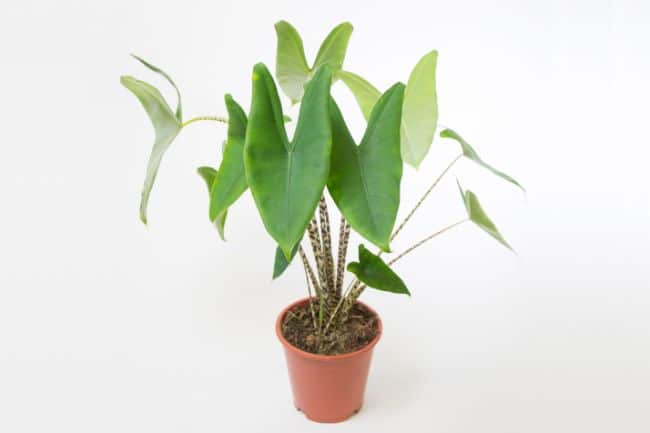
Toxicity
The vibrantly striped stems of the Alocasia zebrina may be Nature’s warning: the plant is poisonous if eaten by people or pets.
Foliage and other plant parts contain toxic calcium oxalate crystals that cause nausea and vomiting. Plant parts and sap may also cause skin and eye irritation on contact.
One Variety, Many Names
The Alocasia zebrina has a high degree of natural variation, a fact which causes some consternation in botanical circles. These variations can carry official-sounding names: Alocasia Reticulata Zebrina, A. wenzelii, Alocasia Tigrina, and Alocasia ‘Tigrina Superba’ … but are all formally classed as Alocasia zebrina.
Some individual Zebrinas have reticulated leaves, others show differing width or thicknesses. Even the leaves on a single plant can show variety. The confusion has led to a proliferation of names given to ad hoc “cultivars.” Even though various plants may have minor differences, they aren’t considered to be distinct lines.
Formally, the Alocasia zebrina is the only recognized plant species from the Philippines with a striped stem and arrow-shaped leaf. Until research discovers unique varieties of striped-stem Alocasias, all variants exist under the same name.
Pests And Diseases
A healthy Alocasia zebrina isn’t particularly susceptible to pests or disease, but they aren’t immune, either. Droughts or overwatering can make them more vulnerable to infestations.
Mealy Bugs are probably the most common insects to watch out for, but the plant can be subject to the typical houseplant infestations of aphids, scale, or mites.
Check routinely under the leaves and along the stem for suspicious activity. You won’t have much trouble spotting an infestation if it’s far enough along to cause foliage yellowing or deformity.
Treat with insecticidal soap or light horticultural oil. Make sure to cover the plant thoroughly. This treatment is mild and doesn’t overstress the plant, but it must come into contact with the pests to be effective. Repeat the process every five to 10 days until the problem in resolved. Read this article about identifying and treating common houseplant pests if you are having problems.
Moisture Breeds Problems
Over-watering can trigger fungal issues, including leaf-spot disease and botrytis … and, of course, root rot. Prevention is the best method of control.
Proper watering and good sanitation are key. When you water, it’s best to only get the roots wet and not the leaves. Ensure adequate air circulation to keep the leaves dry. Read more about identifying and treating common houseplant diseases here.

